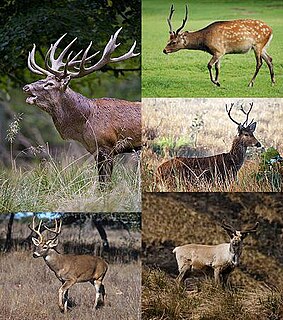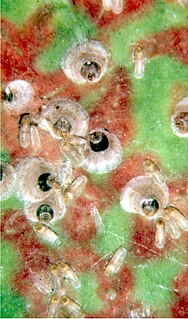
Equidae is the taxonomic family of horses and related animals, including the extant horses, donkeys, and zebras, and many other species known only from fossils. All extant species are in the genus Equus. Equidae belongs to the order Perissodactyla, which includes the extant tapirs and rhinoceros, and several extinct families.

Eagle is the common name for many large birds of prey of the family Accipitridae. Eagles belong to several groups of genera, not all of which are closely related. Most of the 60 species of eagle are from Eurasia and Africa. Outside this area, just 14 species can be found—2 in North America, 9 in Central and South America, and 3 in Australia.

Deer are the hoofed ruminant mammals forming the family Cervidae. The two main groups of deer are the Cervinae, including the muntjac, the elk (wapiti), the fallow deer, and the chital; and the Capreolinae, including the reindeer (caribou), the roe deer, and the moose. Female reindeer, and male deer of all species except the Chinese water deer, grow and shed new antlers each year. In this they differ from permanently horned antelope, which are part of a different family (Bovidae) within the same order of even-toed ungulates (Artiodactyla).
A genus is a taxonomic rank used in the biological classification of living and fossil organisms, as well as viruses, in biology. In the hierarchy of biological classification, genus comes above species and below family. In binomial nomenclature, the genus name forms the first part of the binomial species name for each species within the genus.
Binomial nomenclature, also called binominal nomenclature or binary nomenclature, is a formal system of naming species of living things by giving each a name composed of two parts, both of which use Latin grammatical forms, although they can be based on words from other languages. Such a name is called a binomial name, a binomen, binominal name or a scientific name; more informally it is also called a Latin name. The first part of the name – the generic name – identifies the genus to which the species belongs, while the second part – the specific name or specific epithet – identifies the species within the genus. For example, humans belong to the genus Homo and within this genus to the species Homo sapiens. Tyrannosaurus rex is probably the most widely known binomial. The formal introduction of this system of naming species is credited to Carl Linnaeus, effectively beginning with his work Species Plantarum in 1753. But Gaspard Bauhin, in as early as 1622, had introduced in his book Pinax theatri botanici many names of genera that were later adopted by Linnaeus.

Anseriformes is an order of birds that comprise about 180 living species in three families: Anhimidae, Anseranatidae, and Anatidae, the largest family, which includes over 170 species of waterfowl, among them the ducks, geese, and swans. Most modern species in the order are highly adapted for an aquatic existence at the water surface. With the exception of screamers, all have phalli, a trait that has been lost in the Neoaves. Due to their aquatic nature, most species are web-footed.

Suidae is a family of artiodactyl mammals which are commonly called pigs, hogs or boars. In addition to numerous fossil species, 17 extant species are currently recognized, classified into between four and eight genera. The family includes the domestic pig, Sus scrofa domesticus or Sus domesticus, in addition to numerous species of wild pig, such as babirusas and warthogs. All suids, or swine, are native to the Old World, ranging from Asia to Europe and Africa.

In biology, a monotypic taxon is a taxonomic group (taxon) that contains only one immediately subordinate taxon.

In zoological nomenclature, a type species is the species name with which the name of a genus or subgenus is considered to be permanently taxonomically associated, i.e., the species that contains the biological type specimen(s). A similar concept is used for suprageneric groups called a type genus.

The Pterophoridae or plume moths are a family of Lepidoptera with unusually modified wings. Though they belong to the Apoditrysia like the larger moths and the butterflies, unlike these they are tiny and were formerly included among the assemblage called "microlepidoptera".

A botanical name is a formal scientific name conforming to the International Code of Nomenclature for algae, fungi, and plants (ICN) and, if it concerns a plant cultigen, the additional cultivar or Group epithets must conform to the International Code of Nomenclature for Cultivated Plants (ICNCP). The code of nomenclature covers "all organisms traditionally treated as algae, fungi, or plants, whether fossil or non-fossil, including blue-green algae (Cyanobacteria), chytrids, oomycetes, slime moulds and photosynthetic protists with their taxonomically related non-photosynthetic groups ."

Tube-dwelling anemones or ceriantharians look very similar to sea anemones but belong to an entirely different subclass of anthozoans. They are solitary, living buried in soft sediments. Tube anemones live inside and can withdraw into tubes, which are composed of a fibrous material made from secreted mucus and threads of nematocyst-like organelles known as ptychocysts. Ceriantharians were formerly classified in the taxon Ceriantipatharia along with the black corals but have since been moved to their own subclass, Ceriantharia.

Cladosporium is a genus of fungi including some of the most common indoor and outdoor molds. Species produce olive-green to brown or black colonies, and have dark-pigmented conidia that are formed in simple or branching chains. Many species of Cladosporium are commonly found on living and dead plant material. Some species are plant pathogens, others parasitize other fungi. Cladosporium spores are wind-dispersed and they are often extremely abundant in outdoor air. Indoors Cladosporium species may grow on surfaces when moisture is present. Cladosporium fulvum, cause of tomato leaf mould, has been an important genetic model, in that the genetics of host resistance are understood. In the 1960s, it was estimated that the genus Cladosporium contained around 500 plant-pathogenic and saprotrophic species, but this number has since been increased to over 772 species. The genus Cladosporium is very closely related to black yeasts in the order Dothideales. Cladosporium species are often highly osmotolerant, growing easily on media containing 10% glucose or 12–17% NaCl. They are rarely grown on media containing 24% NaCl or 50% glucose and never isolated from medium with 32% NaCl or greater. Most species have very fragile spore chains, making it extremely difficult to prepare a mount for microscopic observation in which the conidial chains are preserved intact.
David R. Lindberg is an American malacologist and professor of integrative biology at the University of California, Berkeley. He is also the Curator for the University of California Museum of Paleontology and co-editor of the journal Molecular Systematics and Phylogeography of Mollusks.

In biological classification, taxonomic rank is the relative level of a group of organisms in a taxonomic hierarchy. Examples of taxonomic ranks are species, genus, family, order, class, phylum, kingdom, domain, etc.

Holotheria are a diverse group of mammals that are descendants of the last common ancestor of Kuehneotherium and Theria.
Asterolecanium is a genus of pit scale insects. Asterolecanium is distributed worldwide: species have been found in each of the six biogeographic realms, and nearly all of their respective subregions.

Parlatoria is a genus of scales and mealybugs in the family Diaspididae. There are at least 60 described species in Parlatoria.














